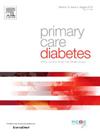血清TG/HDL-C比值对2型糖尿病患者糖尿病视网膜病变风险的队列研究
IF 2.6
4区 医学
Q3 ENDOCRINOLOGY & METABOLISM
引用次数: 0
摘要
背景:糖尿病视网膜病变(DR)是2型糖尿病视力损害的主要原因。本研究旨在阐明2型糖尿病患者基线甘油三酯与高密度脂蛋白胆固醇(TG/HDL-C)比值与DR风险之间的关系,以帮助制定预防和治疗策略。方法:回顾性队列研究纳入2017年1月至2023年12月在我院接受健康检查的1049例符合纳入标准的2型糖尿病患者。所有患者在7年内完成了7次随访。2017年的基线数据被用于分析。采用Kaplan-Meier法、Cox比例风险回归模型和限制性三次样条(RCS)法分析基线血清TG/HDL-C比值与dr风险的关系。结果:共纳入1049例患者,中位随访时间为7年。随访期间,发现124例新发DR,发病率为11.8 %。随着基线TG/HDL-C比值的增加,DR的发生率呈上升趋势。在Cox比例风险回归模型中调整了各种潜在的混杂因素后,高TG/HDL-C比值水平被确定为DR的危险因素(HR=3.04, 95 % CI 1.55-5.98, P = 0.0029)。在剂量-反应关系分析中,TG/HDL-C比值与糖尿病视网膜病变(DR)风险之间存在显著的非线性关系(非线性P值= 0.029)。当TG/HDL-C比值达到3.3时,DR风险显著增加(HR = 1.56, 95 % CI: 1.17-2.10, P = 0.003),之后趋于平稳。结论:高TG/HDL-C比值与DR的发生密切相关,对DR的发病有一定的预测价值。数据可得性:支持本研究结果的数据可由通讯作者合理要求获得。由于与资助机构的保密协议,这些数据不公开。本文章由计算机程序翻译,如有差异,请以英文原文为准。
A cohort study on the risk of diabetic retinopathy in type 2 diabetes patients with serum TG/HDL-C ratio
Background
Diabetic retinopathy (DR) is a leading cause of vision impairment in type 2 diabetes. This study aims to clarify the association between baseline triglyceride to high-density lipoprotein cholesterol (TG/HDL-C) ratio and DR risk in type 2 diabetes patients to aid in prevention and treatment strategies.
Methods
This retrospective cohort study included 1049 patients with type 2 diabetes who met the inclusion criteria and underwent health examinations at our hospital from January 2017 to December 2023. All patients completed seven follow-up visits within seven years. Baseline data from 2017 were utilized for the analysis. The Kaplan-Meier method and the Cox proportional hazards regression model and restricted cubic spline (RCS) method were employed to analyze the association between baseline serum TG/HDL-C ratio and the risk of DR.
Results
A total of 1049 patients were included in the cohort, with a median follow-up period of seven years. During the follow-up period, 124 new cases of DR were identified, with an incidence rate of 11.8 %. The incidence of DR showed an upward trend with increasing baseline TG/HDL-C ratio. After adjusting for various potential confounding factors in the Cox proportional hazards regression model, high TG/HDL-C ratio levels were identified as a risk factor for DR (HR=3.04, 95 % CI 1.55–5.98, P = 0.0029).In the dose-response relationship analysis, a significant nonlinear relationship was observed between the TG/HDL-C ratio and the risk of diabetic retinopathy (DR) (nonlinear P value = 0.029). The risk of DR significantly increased when the TG/HDL-C ratio reached 3.3 (HR = 1.56, 95 % CI: 1.17–2.10, P = 0.003) and then leveled off.
Conclusion
High TG/HDL-C ratio is closely associated with the occurrence of DR and has a certain predictive value for the onset of DR.
Data Availability
The data that support the findings of this study are available from the corresponding author upon reasonable request. The data are not publicly available due to confidentiality agreements with the funding organization.
求助全文
通过发布文献求助,成功后即可免费获取论文全文。
去求助
来源期刊

Primary Care Diabetes
ENDOCRINOLOGY & METABOLISM-PRIMARY HEALTH CARE
CiteScore
5.00
自引率
3.40%
发文量
134
审稿时长
47 days
期刊介绍:
The journal publishes original research articles and high quality reviews in the fields of clinical care, diabetes education, nutrition, health services, psychosocial research and epidemiology and other areas as far as is relevant for diabetology in a primary-care setting. The purpose of the journal is to encourage interdisciplinary research and discussion between all those who are involved in primary diabetes care on an international level. The Journal also publishes news and articles concerning the policies and activities of Primary Care Diabetes Europe and reflects the society''s aim of improving the care for people with diabetes mellitus within the primary-care setting.
 求助内容:
求助内容: 应助结果提醒方式:
应助结果提醒方式:


